

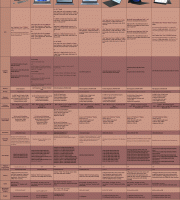
Less Control or Less Secrets?
Three centuries before your eyes met with these ponderously chosen words – humour me with the tenses, it lends the site a certain character – the world of desktop computing was delicately sprawled on a pin…and a tablet and a phone and other, pernicious portable, pretenders to the swivel chair. But many who declared it at death’s door were “types”. Tiresome types. Types with tedious tendencies. Types who, for the preceding decade had purchased their computers in boxes depicting a smiling father filling in a spreadsheet, from places illuminated by noxious neon lights and people wearing mostly nylon whose handshakes were inextricably bound to extended insurance policies.
They meant no harm, but to them the PC was a kettle, or a toaster or a potato. Something to scold when it goes wrong and forsake when it faithfully delivers and the task of keeping one well maintained was as worthy of their attention as the communities of woodlice inside their towers , or the 10.000 viruses brought about by their cursedly stupid clicks on links promising free stuff like a spreadsheet application, even though they had one that worked flawlessly. All of which culminates in their arrogant dismissal of PCs on the pretext of their being slow, unreliable and redundant since acquiring their adorable and resplendent iPad Air, which isn’t working because they forgot to charge it after filling in spreadsheets all night.
In every field there are novices, dabblers and experts and when it comes to debating those less well versed, even if through no fault of their own, the frustrated and abused kick downwards as I just did.
Overclocking video cards was a relatively niche subculture in 2014. Many artisans, proficient at manipulating multipliers, B clocks and FSBs would nonchalantly waive the opportunity to enlist their GPU for a top up. But a recurring opinion divulged by elite practitioners throughout the Maxwell’s impressive reign was that Nvidia had enforced draconian limits on its voltages and frequencies. Forums and tech-sites expounded this argument in such breadth and detail that my head began to spin faster than a Vantec Tornadno. Notwithstanding, I persevered, and via the odd lucid moment compounded with fragments from this site’s shambolic archives, endeavoured to formulate a clearer picture.
Mechanisms to manage thermal and power limits were nothing novel and had been an indigenous part of a CPUs specification long before the video card’s vulnerabilities were even considered. Furthermore, their fundamental characteristics scarcely differed, in spite of what manufacturers claimed, and the confounding illusions scientifically minded journalists conjured up.
Having perused yet further articles, thesis like in scope and scale, many of which dedicated torrents of text to impossibly complicated forms of heat and current regulation, I initially felt the compulsion to learn every word, lest the wisdom should someday complement a bout of convivial philosophical debate, perhaps over a glass of whisky.
Then, mercifully, I realised how much could be curtailed or re-interpreted at no cost to any useful long term knowledge. Yes, I know, pot and kettle. It takes one to know one. The irony is so thick you couldn’t cut it with a claymore and so forth. But at least I acknowledge and ridicule my irony, in itself ironic since that’s how most will defend theirs.
Thus, in an attempt to prove my reckless assertion, I shall proceed with clarity.
Fact. Every single one of these automated algorithms and precautionary processes, no matter how sophisticated their design or operation, was conceived with two things in mind, degrees and watts and how best to make their numbers smaller.
As far as I’m concerned, that was, and is, it. Where elitists actively sought to obfuscate, mulling exhaustively over “target temperatures”, “throttling” “granularity, “algorithms”, “Voltage offsets” and “fan curves”. They merely meant that one, or both of the above was taking place, the making lesser of degrees and watts. They were also were resentful and felt disillusioned, because their traditional, toilsome tampering was becoming of far less relevance to their quest for speed. These “limits” were misconstrued, and merely appeared as such to them because they revealed too many inside secrets and introduced universal procedures for optimization.
The first card ever to have implemented driver level control over its TDP was AMD’s Deep fried Double Decker Cayman, the HD 6990, emerging from its lair in 2011. The Antillies, as it was also known, had a default power limit of 375W. Following a single sacrificial click that allegedly voided your warranty, this value became malleable over a range of 40%, causing the ravenous reptiles to suck upto 450W from the national grid.
Before the Antilies protective measures against temperature and current existed in and a fixed, furtive state, inaccessible via soft tipped tools and unknown to all but those who had waded though 200 pages of certified guidelines and specifications….in print as fine as this. Additionally, the procedure for unlocking a GPU’s adrenal reserves necessitated significant research and an element of risk, but to these experts, it was all part of an enlightening and rewarding adventure.
The fun afforded them by hunting for a hacked BIOS, locating one that appeared to match, tentatively flashing it at the DOS prompt, wondering whether their system would boot. Then when it did, seeing their VCores bolstered and frame-rates enhanced. Everything felt positive and empowering because they had pushed boundaries and given rise to beneficial changes without the aid of a refined software safety net.
After the 6990’s arrival, Nvidia, AMD and a stable of shrewd third parities, were progressively astute in identifying and assuaging an enthusiast’s demands before releasing their wares into the wild. Proprietary applications, previously the privilege of fifty lucky customers and riddled with options to alter settings in the finest increments imaginable was soon the accepted norm.
The performance potential and techniques in attending to it, conquered new heights and catered for the tweaker more generously than ever. Catalysts that hadn’t existed, or were previously an enigma to all without electronics degrees, promptly begged for adjustment. Dozens of utilities with alluring and intuitive graphical interfaces, handed Handy Andy of Average Avenue the ability to conscientiously calibrate voltages, fan velocities and temperatures. One simple point click and drag to raise a card’s TDP, or apply a more aggressive fan profile meant even stock furnished variants could bestow astonishingly high returns.
It sounds immensely exciting but to the experts, the magic had withered away. Extensive and useful functions that in truth, permitted far greater control subconsciously felt restrictive due to their substantial promotion and branding and at pre-launch press events. All was now in plain sight. No matter how liberally they could tinker with Celsius, amps, acoustics and workloads, they were now vividly aware that one omnipresent ordinator would descend like a jack hammer when his patience was pressed.
The consequences of these factory born suppressors varied dramatically from one card to the next, though their duties were as rudimentary as a drone’s conscience:
1: Reduce Energy
2: Reduce Temperature
Sometimes both, but always one, and the only methods in the whole of the known universe to effectively prolong a GPU’s lifespan.
Let us jump to the present and for once, see how simple we can keep things with some refreshing visual aids.
Try to think of all these factory enforced protection schemes as part of a cataclysmic Orwellian nightmare, or capitalism at the core of the 80s or a medieval feudal system or better still, ranks in the military hierarchy, or the 1960s cult TV serial “The Prisoner” starring Patrick Mcgoohan, remember? “I’m not a number, I am a free man” .
No matter how many different readings your monitoring utility contains, there will always be an omnipotent Napoleon sitting atop the pyramid, one Gordon Gecko, a sole Henry VIII or supreme Commander in Chief. A singular “Number one”…probably wearing a chimp’s mask. Worry not, there’s a more succinct analogy impending, I composed that one to communicate some amusing cultural references to distract those who deem the following desperately mundane. Go on, Google Gordon Gekko.
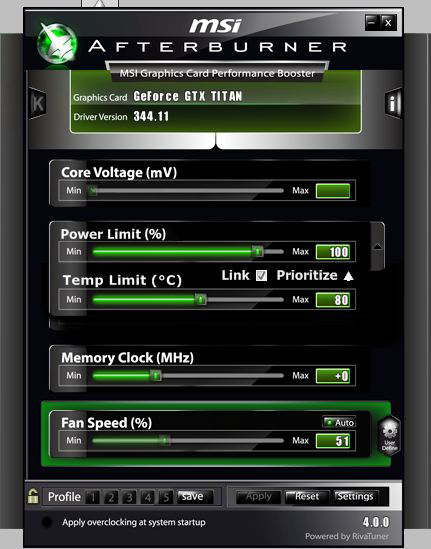
In MSI’s After Burner there are no less than five individual data streams that relate to power and one to temperature.
They are:
GPU OV Max Limit
GPU Voltage Limit
GPU Power Limit
GPU Utilization Limit
GPU Temp Limit
Things become easier to understand if we refer to the “limits” as “limit-ers”. According to the readings Afterburner presents us, these limiters have no granularity – Ah! there’s another ubiquitous, trendy word technologists are loathed to tire of – they rise and fall in straight and not curved lines, implying that, like a digital signal, or old fashioned butchers bulb, they are either active or AWOL. The other figures pertain to resources and speed and can, for now, be disregarded since they are statistical by-products of the limiters’ activities and do not originate from them.
As the temperature and/or energy demands increase one limiter will hand over to the next in command and in instances where the user has set their target temperature or voltage on a borderline, they will relinquish and procure control continuously, and in order of priority.
Between them, all are observing two basic directives.
1. Keep the GPU under 80 degrees, The Titan’s absolute temperature limit.
2. Keep the TDP under 250W, the card’s maximum power limit.
To establish who is doing what, and when, we need to take practical measures.
There are few games that will efficiently extract every watt from a modern GPU, especially in its stock state, and since we need to be able to observe data simultaneously, Geek3ds “Furmark” stress test is a preferable choice.
When run on GTX TITAN Card with all settings at their defaults, the first to leap to the GPUs rescue is the “Power Limiter”. Note the wildly fluctuating green line under “GPU Power Limit” in the image, this occurs the second the test commences.
Looking down, we discover that the “GPU Utilization Limiter” is also vigorously active and the trace is the power limiter’s mirror opposite.
This particular “limiter” would be better classified a as a “regulator” and is the lowest ranked in our graphical chain of command, though of no less significance to speed. Its deployment or dismissal depends on whether any headroom exists for the boost clock supplement to be sanctioned.
So long as power consumption and temperature remain within their staunchly designated margins, it will instruct its host to administer the necessary nitrous, but when either limit is compromised, or the boost bonus is being applied to capacity, its duties will accordingly and abruptly cease. In 2d mode, it remains permanently engaged due to the graphics card’s core and memory being relegated to their “resting” frequencies.
Now let’s examine the other readings, beginning with the top most trace.
We can see the “GPU1 Temperature” is handily hovering around 92-93 degrees, shown extreme right, two degrees under its critical threshold. Meanwhile, the power draw – “GPU1 Power”, fourth line down, is hitting its peak at 102% and being restrained to 97%.
The GPU1 Core Clock, second line down is poised betwixt 666-715 mhz, and “GPU1 Usage”, second from bottom, is topping out at 98-100% for most of the time, with the occasional pronounced sag.
Note how the readings generated by each limiter (“GPU Utilization Limit” and “GPU power Limit”) coincide with the smaller peaks and troughs in the traces for “GPU1 power” and “GPU1 Usage”.
“Usage %” is being influenced by the “Utilization Limiter” and “power %” defined by the “power limiter”, while the traces applicable to each paring show identical periods of activity and in inverse motion.
Each of these limiters is alternatively regulating the card’s operating state according to whose appointed task is being executed. As the core’s boost frequencies cannot be allotted when the card’s TDP is exceeded, both are rapidly conceding and obtaining command on a mutually exclusive basis.
The core frequency is constantly affected by both our authoritative automatons as their aid is urgently sought, though its trace’s fluctuations mostly correspond to those of the power limiter in light of it being the busier of the two. It’s very difficult to identify the exact sequence of cause and consequence from such dense readings.
Suffice to say that because the temperature trace is relatively smooth and its minuscule movements are frequently not aligned with those exhibited by the other three, we can conclude the TDP is presently the determining factor as to which limiter(s) is/are being summoned for service.
At this stage of the test, we have reached a plateau because conditions only require these two limiters to be active and Furmark is a synthetic benchmark that has placed a fixed load on the GPU, as opposed to a game that might bring about a sudden, heavy demand immediately after loading a new level, or when the screen is densely and sparsely populated over short, intensive periods of emphatic enemy evisceration.
Now, let’s see what happens when we implement a significant change and hopefully, force the next paratrooper to perform his party piece. On the Afterburner control panel, there is a small arrow entitled “Prioritize” residing between the sliders for power and temperature limit. Presently, it is pointing upwards, towards the value that declares the card’s power target, currently set at 100%.
This means when under pressure, the GPU is giving priority to regulating its energy demands in compliance with the TDPs limit of 250 watts and ignoring its thermal threshold of 80 degrees, considered the card’s “safe default”, in doing so. As things stand, only when it reaches its definitive perimeter of 95 degrees, will the temperature limiter be called into play. So far, as we’ve seen, this has not occurred.
But with one click, we can force our temperature target of 80 degrees to be the Titan’s raison d’etre and as a result, re-prioritize the temperature and power limiters.
Here we go….
As expected, we witness the “temperature limiter” – fifth line down – willingly surge into life, relieving the power and utilization limiters of their posts and standing stoically as it attempts to meet our request. Core and memory speeds are concurrently and severely throttled as another effective means of minimizing heat, the GPU’s power draw drops dramatically to below 50% and the usage trace exhibits troughs deeper than the Marajana trench.
In contrast to the previous scenario, where two limiters were engaged with individual tasks, we now have one limiter invoking changes on three, albeit with two fleeting interventions from utilization limiter. In short order, the temperature levels off at 80 degrees.
The term “temp limit” in this context is a little misleading since changes in temperature are being affected by a heat or energy source. Your saucepan of hot, creamy porridge won’t cease bubbling unless you turn that fiery Aga down a few notches. When you do, you are limiting power in order to reduce temperature as opposed to lowering temperature directly. Essentially, this is another form of voltage limitation and ought to be labelled as such.
What if you blew on the porridge, wouldn’t that directly lower the temperature?
Yes Mr. Forum expert, I did say “in this context”.
The “Voltage Limiter” is also deceptively defined since it does not represent the imposition of a safety measure but instead illustrates when the card is receiving the most pronounced injection of pace permitted by GPU boost. In other words, it denotes when catalysts and workloads are comprehensively favourable and all pipelines are firing in fearful frame fracturing ferocity. Like the Utilization limiter, its presence was predicated on the card’s prescribed parameters. Hence, the reason why it was never active on this occasion, was because Furmark instantly expended every available watt and precipitated conditions that were too hot for the maximum boost bin to be authorized.
Coercing the final limiter into action was a task too tough. Tempting fate a tad, I raised the Titan’s power limit from its default of 250W to 265W TDP (106%), but all this achieved was to delegate control back to the power and utilization limiters” neither of which yielded to any except each other, despite restarting the benchmark multiple times. I could spend hours, days, or however long it takes for my regal rendering Romeos to frizzle and fry into ROP shot relics putting my mind to this mystery but would far rather leave such dangerous dicing to those who axe X-boxes, pulverize Playstations, trample tablets, incinerate iphones and amass more Youtube hits in a week than I shall in a hundred lifetimes.
Best guess? Since the Titan’s indigenous survival instincts ultimately depend on its TDP, it would be logical to assume the abbreviation “OV MAX” refers to the proverbial General, the “Chief Sentinel” or “None Shall Pass Bridge Troll”. Of course, we must be mindful that all this data originates from third party software and precisely what each of these values, legends and labels, especially the limiters, correspond to on the card in real hardware terms is virtually impossible to ascertain….at least…it was in my case
But hankering back to useful knowledge and the joys of clarity, does it really matter?
The reducing of degrees by the lessening of watts and the throttling of clocks.
Heat=Bad. Result=Potentially shorter lifespan for GPU.
Mission=Make GPU run cooler.
Solutions.
Increase the Fan speed.
Reduce the clock speed.
Reduce the power itself.
Examples.
Note that the descriptions refer to each card’s definitive safety measures, the post it will flat out refuse to abandon in approval of its master’s avarice, irrespective of all other variables. In the Titan’s case, there are two “non-negotiable clauses”, its thermal tolerance of 95 degrees and TDP of 265W and as we have witnessed, the protocols to preserve them are swift and decisive.
Wait a moment….cry the tweakers in uncompromising unison.
Temperature is ultimately subordinate to power, it depends on energy, it can be forced to diminish faster, made to radiate efficiently. What if I pacified my pipeline worn primate with the milk of human kindness…..WATER! Perimeters would be safe, those “temperature rovers” would stay submerged, permanently poised on “orange” alert. Shaders could shine, Cuda’s would crunch, Fahrenheit need no longer foil my quest for fame and frames.
Well, when stranded in the sands of gruelling gaming, febrile folding and murderous mining, it would indeed be far simpler to dial away your dearth of degrees than casually cruise over your allotted wattage. There are astrophysical equations, described as “beautiful” in the mellifluous Mancunian musings of Brian Cox that solidly prove the reflective tendencies of power and heat as each rises and falls. However, under these circumstances, to guarantee a correlation consistent enough to afford a credible advantage would be to invent a way of controlling the weather or of making a gas bill a riveting read.
Let’s briefly examine why. Ha! why sure. Just as I insisted things would be simple a veritable eternity ago. Here is a graph depicting the result of a revealing experiment conducted by TechPowerup.com, very likely the internet’s most productive source of studies exploring the temperament, psyche and genetics of the modern GPU.
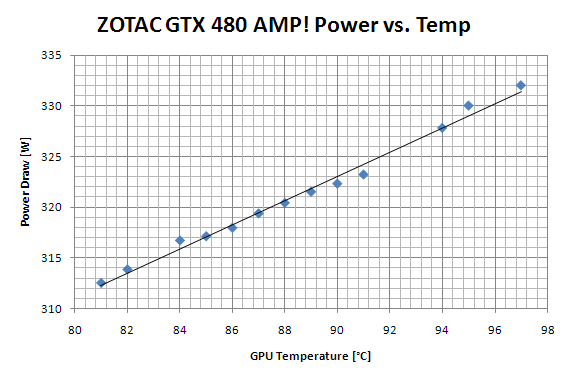
By convenient coincidence, the experiment’s subject was famously voracious for voltage and will provide us with a best case scenario to avail the ecstasies of exotic cooling. The feriy fermi in flagship form under capable care of Zotac. Their traditional “amplified” remix appeared dapper, decked out with a stylish black shroud whose twin topaz fans wove whirls of amber abundance, and despite boosted speeds out of the box, the most aggressive of any rival’s reversion, consumed an average of 25 watts less than pain old vanilla.
The test measured the card’s power draw as it increased from 312 to 332 watts, a range of 20 watts and offset the values against its core temperature, which rose from of 80 degrees to 98, a window of 18 degrees. Readings were taken with an ornate appliance it would take me longer to turn on than for you to have read this far, and concluded that under full load, every additional degree incurred a 1.2W penalty.
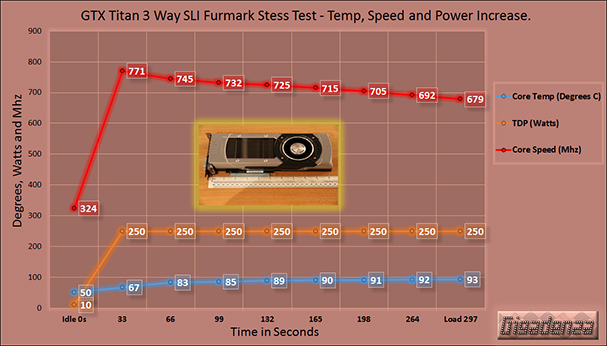
Here, in a second graph, is a less scientifically secure illustration of our initial test. As you’ll recall, the Titan was inhibited by its electrical allowance whilst its temperature tip toed two degrees inside the GPU’s absolute limit, demonstrating that even the humble stock cooler was equipped to prevent the card’s heat precautions from taking precedence over its battle to preserve power.
Its Idle temperature was 50 degrees, which climbed to 93 degrees under load, a window of 43 degrees. However, to make our imminent calculations commensurate with those above, we need only concentrate on the 15 degree increase from 78 to 93 degrees.
Prior to the benchmark beginning, afterburner shows power consumption to be non-existent, which of course is impossible, so let’s agree to settle on 10 watts or 4% as per various reviews. At load it reached its limit of 250W or 100%, an operating range of 246W or 96%. Again, to align our equations with those of Tech Powerup we only consider the concluding 20 watt rise.
Summary:
Zotac GTX 480 AMP – 312-332 watts
Vanilla GTX Titan – 228-250 watts
Zotac GTX 480 AMP – 81-97 degrees
Vanilla GTX Titan – 78-93 degrees
It is here we encounter a hitch. Afterburner’s power meter is a flat line, implying the card’s TDP was exceeded the moment Furmark commenced and variance thereafter was negligible. Unfortunately, I am bereft of the apparatus to accurately verify voltage, so the sake of argument, let’s pretend the both card’s power and thermal readings ascend at a fixed angle over the same 15 degree and 20 watt ranges – they wouldn’t, but my weariness permits such a leap of faith.
The Titan’s power envelop is 250W compared to the the Zotac’s “self-determined” 332w, a difference of 82 watts, or 25%, hence, let’s also assume the card is a quarter thriftier with its resources and divide 1.2 watts (the value per degree for the Zoltac) by 4, then multiply by 3 giving us estimated comparison of 0.9 watts per degree. Finally, we’ll multiply 0.9W by our temperature window of 15 degrees and we have a total ascent of 13.5 watts in contrast to the 480s 18 over the same thermal range.
1. The Fermi, a positively arcane GPU will vehemently violate its TDP to max out its megahertz.
2. The Kepler and almost every other GPU succeeding the crimson Cayman, are duty governed by their TDP and will never compromise it in pursuit of their core potential.
3. Allowing a TDP tied GPU to live in liquid luxury induces a dramatic environmental shift would return a lower rate of interest because the swell in temperature and power would incrementally and radically alter under the new conditions. Current would climb faster than Fahrenheit and the card’s allotted amperage would expire quicker than the patience of a chaffer awaiting the arrival of a three toed sloth on a Friday night branch bash.
A Parting Question Which May Have no Answer.
What value in real numerical terms and as a percentage relative to its embodied thermal threshold, must a graphics card’s TDP be before water, phase change, or any exotic cooling artistry can be of optimal benefit to its core speed? I anticipate a deluge of dependencies and accept the answer would differ in accordance with each GPU’s native attributes, though in many respects this would make for a far more intriguing case study. It could be conducted on any card whose operating conditions were constrained by its current account.
An Example
The Titan’s allocated wattage is 250W with a complementary but miserly overhead of 16 watts giving us a total 266W, or range of 106%. It’s temperature tolerance is 80 degrees by default but it will amend this to 95 under dire provocation and assuming its TDP isn’t violated first. This opens a window of 119%. The card’s core ticks over at 837mhz but with an amenable mix of beverages, boosts to over 1100mhz have been documented, a spectrum of roughly 124%.
From our experience with Afterburner, we’ve witnessed that even an air cooled Kepler exhausts its energy quotient prior to overheating. So what of our mysterious wattage warden if water were a factor. Brother “OV Max”. No doubt his strength would be sought and his orders observed. Could he in some way be neutralized, removed, expelled? Aren’t your idle hands itching?
What would the TDP and core frequency need to be before electron migration* (see footnote 1) posed a serious threat? In laymen s terms how fast could these things go and under how much steam before they began souring themselves to shreds
I profess to being a Titan adopter and am vividly aware of the creature’s innate conservatism, but please, no finger pointing. No cynical sneering or sniping. No cries of “Awww, he wantonly wasted his wages and won’t do his own dirty work”. I’m simply curious. Could not we add a third column to this page entitled “Desired TDP”?
What I’m really NOT saying is:
Greetings to all richer than creases and with more technical expertise than an F1 paddock, solicit your synergies of fanciful weaponry and in the noble name of the armchair nerd, perform some subtle acts of persuasion on a massive collection of contemporary graphics cards, and promptly publish some flavoursome facts…for you do it so well. Understood? I am in no way saying, implying or thinking that, even when I typed it just then, the thought never occurred, I solemnly swear…
I endeavoured to solve part of this riddle with a spate of rigorous research. Click here to be bored again.
Electron Migration (Footnote 1)
Electron migration is an phenomenon brought on by excessive heat or electricity surging through delicate components and causing electrons to deviate from their pathways. Over a varying period of time, depending on the severity of conditions, a progressive and permanent degeneration of silicon will occur, leading to a gradual decline in performance and stability and eventually, a spontaneous cessation of all useful functionality….DEATH.
It is the Nemesis of all over-clockers. A dour danger to RAM, CPUs, GPUs or any chip you can’t have with fish. An insidious assassin, baring a a grin as broad as that lighting up its unwitting usher, who’s spirit and senses are seduced by the enchanting endorphin elixir, further enriched by the ecstasy of an evidently productive pilgrimage for power and poise. A pernicious plague, impossible to diagnose until damage has been indelibly delivered.
Many associate it entirely with heat, though once this hazard has been nullified by, just to cite a recent and wholly coincidental example, water cooling, voltage will prove equally if not more fatal. It is precisely what TDP governors, core throttles and thermal protection circuits are programmed to mitigate. After all, who can name a company , no matter how illustrious that wants their gorgeous goods exploited in bad faith, brazenly broken, then returned under false pretences?
Tweaker: Yes, that’s right Mr. Etailer. I was running Furmark, Prime95, Folding@Home, exporting a 4k video file in Premier, updating my Steam library, backing up my FLACS, and half way through relishing a resplendent Blu-Ray remastering of all twenty four seasons of twenty four…with everything set to stock…
Mr Etailer: And how often do you do this?
Tweaker: Oh, whenever I’m not busy with Battlefield 4 bash in 5k plus Gsync.
Mr. Etailer: And how often do you do that?
Tweaker: Er, whenever I’m not doing all that other stuff.
Mr. Etailer: Be straight, what’s your average daily uptime?
Tweaker: It hasn’t been off since I built it last month, until a two hours ago, we had a power cut and then it wouldn’t post. It’s one of the video cards. I run 4 way SLI and tested each individually, the other three boot fine.
Mr. Etailer: Everything at stock you say?
Tweaker: Absolutely.
Mr Etailer: All speeds and voltages?
Tweaker: That’s right.
Mr. Etailer: It’s amazing you didn’t use any those great tuning apps, Afterburner, Precision. They’ve got tons of options to play with, could get a shed load more speed.
Tweaker: I’ve never heard anybody wink so loudly and I know, I’ve read the forums. They’re clocking the nuts off these things, quite a few hacked BIOSES out there now. Think they’ve busted the TDP without a hardware mod. I guess I don’t need the boost just now.
Mr. Etailer: Go to this thread on Anandtech, there’s a full OC guide and loads of stuff about water and phase change, about 60 pages of tips, found it dead useful, got mine an extra 200mhz .
Mr. Etailer: Ok sir, Emailed an RMA form, send it back and will chuck to the vendor, should have you’e replacement shipped direct in the next three days.
Vendor 1: Getting a load of these back. Think it might be design, fabrication, or something to do with the way our ingenious software seduces all whose sleep depends on five free frame per second. That Green Eyes, I almost pity him.
Vendor 2: Pity old Green Eyes?! I’d sooner pity a Nazi hag-fish . Trust me, if he ever found a way to to sell these things himself, we’d be gum on his great green galoshes. But the common touch is a rare gift, we have it, he doesn’t, and they all lived affluently ever after.
Giant Green Eyes: This is absurd, I shall not be unduly defiled in such frivolous fashion. My work was impeccable and I’m awash with more returns than ten thousand Walmart warehouses on Boxing Day. These chips were crisp, cut fresh from their wafer’s prime and binned to perfection, they have no flaws, they are no duds. Those vexatious vendors, they’re supposed to work alongside me, I employed them as my partners, to shield me from the shenanigans of treacherous tinkerers and their spurious claims. Satisfy the masses and no secrets for the super savy. Instead they devise and divulge ways of destroying my masterpieces to their avail and at my expense.
I must tolerate it no more and be learned of their techniques. I’ll extract these turgid, tawdry tools from my own quarry, subsume them in my drivers with an achingly alluring control panel none can resist. They will become a permanent part of my “experience”, a privilege accessible on my terms alone. Moreover, my next GPU will be greener than the fields of England and better protected than the Pope’s pinkies. No more perks. One day my clusters of Cudas will conquer, imperiously command every pixel in the heavens and render supreme.
Maxwells Maxwells Everywhere and not an Grain of Coffee
Prior to winding things up, how about a cursory glance at some Gym204 Bunnies. Ha! Now that one took me five days to dream up!
My sentiments at the outset of this laboriously long winded affair were clear enough and I’ve no cause for needless negativity. Nevertheless, during its conveyance, I was struck by the flavours of these fudge, pistachio, coffee and walnut Maxwell sundaes and how little they varied from the five servings of Vanilla I sampled the week before.
When observing the image above , it is clear that manufactures were either afraid to experiment and innovate or the most efficient solution for an air cooled video card had already been established. There are five cards pictured but only two principle designs and yet, every base and boost clock value was exclusive to its host.
Memory was a common theme – 4GB and 7010mhz and any further discrepancies related to guarantees and bundled software.
Zotac also moulded a spicy “Omega” encore, which sauntered along at 1202mhz and sprinted to 1304, before excelling themselves with an interpretation of “Extreme” aplomb, and crazy cadenzas of 1291 and 1393mhz.
Significantly, these were the only paraphrases of old Green Eyes’ esteemed and ecocentric best seller to brag elevated RAM frequencies, though the gratuity was minuscule when compared to that of their cores.
The “Extreme Edition’s” over-clocking credentials were distinct from the rest, and offered direct interaction with the card’s low level settings by connecting a USB cable from the card to a front panel controller, then using the enclosed Firestorm software to access the multitude of supplementary options. It was a feature that had made its début on the company’s top tier GTX 680 two years earlier.
And sneaking in before the proof read for a spot of after hours’ Steaming , is another non-radical rework from Galaxy – previously Galaxy – a genuinely inspired and imaginative shift in brand identity. This effort was an fiendishly subtle triple fan tribute to David Hasslehoff and harboured a dual bios, upgraded capacitors and improved power distributors beneath its purring two tone fins.
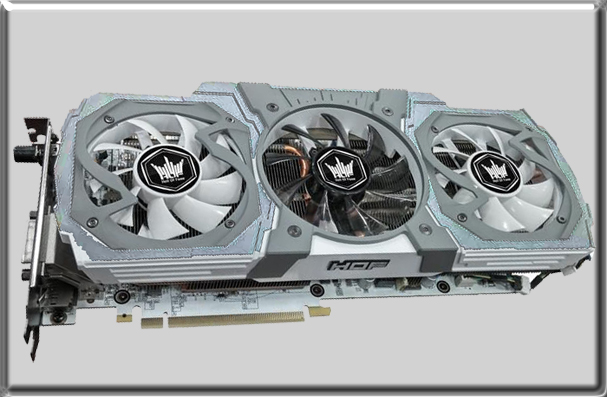
Its enclosed software fostered a utility supposedly developed by amateur artisans, to bypass the Maxwell’s rigorous voltage remand. Imagine that, in the space of a few paragraphs we’ve moved from sophisticated hardware surgery apt to annul your warranty, to shamelessly promoted third party software, engineered to provide the same liberties at the vendor’s risk of indemnity.
Look, Let’s Just Escape Before they Make any More…
One last point from the present. Anybody lusting after one of these highly decorated derivatives should consider their unadorned principal has been known to attain core speeds in excess of 1500mhz (at a voltage of 1.25v) and memory frequencies grazing 7.8ghz. This was achieved via a TDP increase of 25%, the maximum endorsed by Nvida’s predetermined range.
The purpose of this reference is to offer those prone to relieve the family piggy bank of its pier and candy floss budget the chance to consider little Adam’s toffee apple and still eat their own cake. And truthfully, don’t expect to save much more.
In the world of IT, prices are driven by supply and demand to realms beyond all logic and reason. Components balanced on the brink of obsolescence can retail for double their début price solely on the basis of scarcity and to revisit this ramble’s encompassing irony, cards that are “special”, “exclusive”, “gold plated”, diamond edged, allegedly half per customer and with a sample of Vince “Kingpin” Lucido’s DNA are now easier to source than the source from which they sprung.
That’s it folks, my mind grows weary of cache, cores, and working out what tense in which I should communicate. Remember, if in doubt, panic and click purchase!